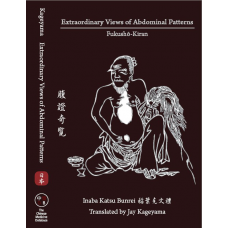Inaba Bunrei’s Fukushō-Kiran (Extraordinary Views of Abdominal
Patterns) is considered to be the most authoritative work on abdominal
diagnosis in Japan. This book distills the writings of Zhang Zhongjing
into practical system of thought on abdominal diagnosis and the Shang Han Lun or Jin Gui Yao Lue formula which treats each abdominal pattern.
During the Edo period, Kampō,
the native Japanese system of medicine began to evolve separately from
traditional Chinese medicine, and abdominal diagnosis within Japan
became more widely utilized among physicians compared to pulse
diagnosis. One reason that abdominal palpation became popular was
because it did not rely on the often complicated diagnostic techniques
of Chinese medicine, as each abdominal pattern is thought to correspond
to a single formula under a theory known as formula-pattern
correspondence. These formula-pattern correspondences are captured in
eighty-two illustrations, along with Inaba’s understandings on the
pattern, formula, ingredients, and dosage. Inaba, like all good
teachers, weaves stories and anecdotes from his lifetime experience of
treating patients into the body of the work. The Fukushō-Kiran
has been expertly translated by Jay Kageyama, and the Chinese Medicine
Database is excited to add this Japanese text to our growing body of
published translations.
| Specs | |
| Number of Pages: | 326. |
| Dimensions: | 6 X 9 inches. |
| ISBN | 978-0-9906029-5-8 |
| Language | Japanese and English. |
| Author | Inaba Bunrei 稻葉克 |
| Translator | Jay Kageyama |
| Dynasty | Edo |
Extraordinary Views of Abdominal Patterns
- Product Code: AP
- Availability: In Stock
-
$65.00
Tags: Abdominal Palpation, Japanese

